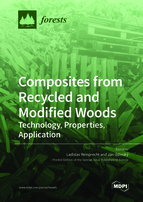Composites from Recycled and Modified Woods – Technology, Properties, Application
A special issue of Forests (ISSN 1999-4907). This special issue belongs to the section "Wood Science and Forest Products".
Deadline for manuscript submissions: closed (15 October 2021) | Viewed by 28900
Special Issue Editors
Interests: wood protection; wood modification; wood composites; material characterization; coatings; biodegradation; non-destructive analysis; service life
Special Issues, Collections and Topics in MDPI journals
Interests: physical-mechanical properties; wood science; wood products; wood composites; wood processing; wood modification; wood-based panels; wood based panels technology
Special Issues, Collections and Topics in MDPI journals
Special Issue Information
Dear Colleagues,
Background and History:
The issue of efficient processing and use of less valuable wood species, bio-damaged logs, sawmill residues, cuttings, chips, sawdust, recycled wooden products, and other lignocellulosic raw materials in the production of wood composites is the focus of several scientific research institutes around the world. Wood composites are mostly produced for a particular application and, therefore, the raw materials, additional additives, production processes, as well as finishing and surface treatments are adapted to this. Research into the optimization of material and technological parameters of the production of wood composites with special properties and applications is still ongoing.
Aim and Scope:
Recycled woods as well as thermally, chemically, or biologically modified woods have the potential to be a base or complementary raw material for (A) construction wood composites used mostly in construction and transport, such as glued prisms (e.g., glulam), glued boards (e.g., blockboards), glued large-area boards from veneers (e.g., plywood, LVL, etc.), or large-area boards from wood particles and fibers (e.g., particleboards, OSB, MDF, etc.), as well as for (B) decorative wood composites used mostly in furniture and building architecture, such as veneered, laminated, coated or plasma-treated large-area boards.
Cutting-Edge Research:
For this Special Issues, we are interested in research on wood composites in the terms of the raw material conditions also encompasses technological processes, including finishing and surface treatments and their individual properties. Development of wood composites with special properties is also of interest.
What kind of papers we are soliciting:
The papers should be focused mainly on material composition (e.g., species, amounts, fractions, and distribution of recycled and modified woods; glues, biocides, fire retardants, other additives), processing, finishing, and properties of wood composites for construction and decorative purposes.
Prof. Dr. Ladislav Reinprecht
Dr. Ján Iždinský
Guest Editors
Manuscript Submission Information
Manuscripts should be submitted online at www.mdpi.com by registering and logging in to this website. Once you are registered, click here to go to the submission form. Manuscripts can be submitted until the deadline. All submissions that pass pre-check are peer-reviewed. Accepted papers will be published continuously in the journal (as soon as accepted) and will be listed together on the special issue website. Research articles, review articles as well as short communications are invited. For planned papers, a title and short abstract (about 100 words) can be sent to the Editorial Office for announcement on this website.
Submitted manuscripts should not have been published previously, nor be under consideration for publication elsewhere (except conference proceedings papers). All manuscripts are thoroughly refereed through a single-blind peer-review process. A guide for authors and other relevant information for submission of manuscripts is available on the Instructions for Authors page. Forests is an international peer-reviewed open access monthly journal published by MDPI.
Please visit the Instructions for Authors page before submitting a manuscript. The Article Processing Charge (APC) for publication in this open access journal is 2600 CHF (Swiss Francs). Submitted papers should be well formatted and use good English. Authors may use MDPI's English editing service prior to publication or during author revisions.
Keywords
- wood composites
- particleboards
- plywood
- recycled wood
- modified wood
- processing
- finishing
- physical–mechanical properties
- service life
- bio-resistance
- abio-resistance







